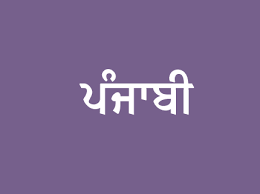Difference between revisions of "Language/Panjabi/Vocabulary/Numbers-and-Time"
< Language | Panjabi | Vocabulary
Jump to navigation
Jump to search
m (Quick edit) |
m (Quick edit) |
||
| Line 161: | Line 161: | ||
<span gpt></span> <span model=gpt-3.5-turbo></span> <span temperature=1></span> | <span gpt></span> <span model=gpt-3.5-turbo></span> <span temperature=1></span> | ||
==Related Lessons== | |||
* [[Language/Panjabi/Vocabulary/Drinks|Drinks]] | |||
* [[Language/Panjabi/Vocabulary/Colors-and-Shapes|Colors and Shapes]] | |||
* [[Language/Panjabi/Vocabulary/Questions-(ਸਵਾਲ)|Questions (ਸਵਾਲ)]] | |||
* [[Language/Panjabi/Vocabulary/Days-and-Months|Days and Months]] | |||
* [[Language/Panjabi/Vocabulary/Geography|Geography]] | |||
* [[Language/Panjabi/Vocabulary/Health-and-Illness|Health and Illness]] | |||
* [[Language/Panjabi/Vocabulary/Feelings-and-Emotions|Feelings and Emotions]] | |||
* [[Language/Panjabi/Vocabulary/Count-to-10|Count to 10]] | |||
* [[Language/Panjabi/Vocabulary/Colors|Colors]] | |||
* [[Language/Panjabi/Vocabulary/Outdoor-Activities|Outdoor Activities]] | |||
{{Panjabi-Page-Bottom}} | {{Panjabi-Page-Bottom}} | ||
Revision as of 21:05, 22 March 2023
Welcome to the third lesson of the Complete 0 to A1 Panjabi Course! In this lesson, we will cover the basics of numbers and time in Panjabi. Knowing how to count, tell time, and ask for the time is essential in any language. Let's get started!
Counting in Panjabi
Let's start with the basics of counting.
Numbers 0-10
In Panjabi, the numbers from 0 to 10 are as follows:
| Panjabi | Pronunciation | English |
|---|---|---|
| ੦ | Shunya | Zero |
| ੧ | Ik | One |
| ੨ | Do | Two |
| ੩ | Tinn | Three |
| ੪ | Chār | Four |
| ੫ | Pānch | Five |
| ੬ | Chhah | Six |
| ੭ | Sat(t) | Seven |
| ੮ | Aaṭh | Eight |
| ੯ | Nau | Nine |
| ੧੦ | Das | Ten |
To say the numbers beyond 10, you simply add the unit's place after the ten's place. For example, to say 11 in Panjabi, you say "gyārah," which means "10 + 1."
Numbers 11-100
In Panjabi, the numbers from 11 to 100 follow a similar pattern.
To say the number 11, you would say "gyārah," which means "10 + 1."
Here is a list of the numbers from 11 to 100 in Panjabi:
| Panjabi | Pronunciation | English |
|---|---|---|
| ੧੧ | Gyārah | Eleven |
| ੧੨ | Bārah | Twelve |
| ੧੩ | Terah | Thirteen |
| ੧੪ | Chaudah | Fourteen |
| ੧੫ | Pandrah | Fifteen |
| ੧੬ | Solah | Sixteen |
| ੧੭ | Satrah | Seventeen |
| ੧੮ | Aṭhārah | Eighteen |
| ੧੯ | Unni | Nineteen |
| ੨੦ | Bīs | Twenty |
| ੨੧ | Ik-vīs | Twenty-one |
| ੨੨ | Bā-vīs | Twenty-two |
| ੨੩ | Tey-vīs | Twenty-three |
| ੨੪ | Chau-vīs | Twenty-four |
| ੨੫ | Pach-pach | Twenty-five |
| ੨੬ | Chhī-vīs | Twenty-six |
| ੨੭ | Sat-vīs | Twenty-seven |
| ੨੮ | Aṭhā-vīs | Twenty-eight |
| ੨੯ | Unthān | Twenty-nine |
| ੩੦ | Tīs | Thirty |
| ੩੧ | Ik-tīs | Thirty-one |
| ੩੨ | Bā-tīs | Thirty-two |
| ੩੩ | Ti-tīs | Thirty-three |
| ੩੪ | Chau-tīs | Thirty-four |
| ੩੫ | Pain-tīs | Thirty-five |
| ੩੬ | Chhi-tīs | Thirty-six |
| ੩੭ | Sat-tīs | Thirty-seven |
| ੩੮ | Aṭhā-tīs | Thirty-eight |
| ੩੯ | Unāltāli | Thirty-nine |
| ੪੦ | Cālīs | Forty |
| ੪੧ | Ik-cāli | Forty-one |
| ੪੨ | Bā-cāli | Forty-two |
| ੪੩ | Tī-cāli | Forty-three |
| ੪੪ | Chau-cāli | Forty-four |
| ੪੫ | Pach-cāli | Forty-five |
| ੪੬ | Chhi-cāli | Forty-six |
| ੪੭ | Sat-cāli | Forty-seven |
| ੪੮ | Aṭhā-cāli | Forty-eight |
| ੪੯ | Unāntāli | Forty-nine |
| ੫੦ | Pachās | Fifty |
| ੫੧ | Ikavan | Fifty-one |
| ੫੨ | Bāvan | Fifty-two |
| ੫੩ | Tiran | Fifty-three |
| ੫੪ | Chauvan | Fifty-four |
| ੫੫ | Pachavan | Fifty-five |
| ੫੬ | Chhappan | Fifty-six |
| ੫੭ | Satavan | Fifty-seven |
| ੫੮ | Aṭhavan | Fifty-eight |
| ੫੯ | Uns
Related Lessons
|
